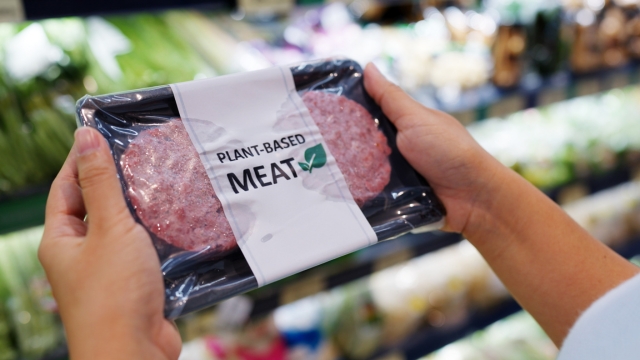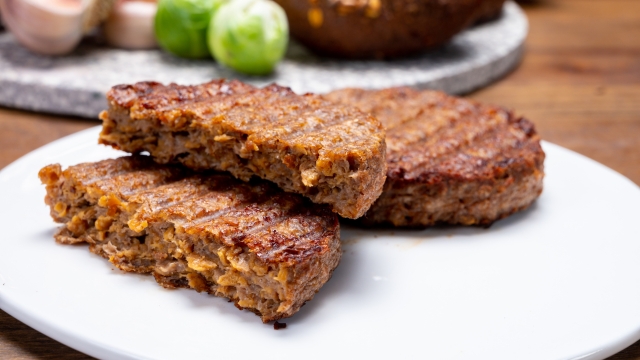In recent years, plant-based meat alternatives have taken the food industry by storm, offering consumers a new way to enjoy their favorite dishes without the health and environmental concerns associated with animal meats. With companies like Beyond Meat and Impossible Foods leading the charge, vegan meat is quickly becoming a staple on grocery store shelves and restaurant menus. But how is vegan meat made, and what makes it so similar to real meat in taste and texture?
Plant-based meats are created using proteins extracted from raw materials, which are then heated and pressed through an extruder machine. Then, fats, coloring, flavor, and aroma are incorporated to make it look and taste more like real meat. This addresses the question of how vegan meat is made.
We will unveil the process behind plant-based alternatives, exploring the ingredients, techniques, and science that go into creating convincing meat substitutes. As we delve into vegan meat, we will also examine its nutritional profile, health benefits, and potential environmental and ethical implications.
Key Takeaways
- Vegan meat has evolved due to advances in food science and technology, creating realistic ‘meat-like’ experiences for consumers.
- The production of vegan meat is more sustainable than traditional animal-based products, providing health benefits while reducing environmental impact and animal cruelty.
- Future innovations will continue to shape the industry as consumer attitudes shift towards plant-based alternatives.

Introduction – How is Vegan Meat Made
Vegan meat, sometimes referred to as “fake meat” or “plant-based meat,” has transformed the way we think about food and our relationship with animal-based proteins. As more people seek to reduce their consumption of animal products for health, environmental, and ethical reasons, plant-based meats have emerged as a popular alternative. This option offers a similar taste and texture to real meat without the associated drawbacks.
Moreover, vegan meats now span a wide range of flavors and textures, from burgers and sausages to chicken nuggets and seafood. This variety caters to diverse dietary preferences and culinary traditions. Its journey from ancient plant-based alternatives to modern innovations has been a fascinating one. Significantly, it has been shaped by evolving consumer tastes, scientific breakthroughs, and a growing awareness of the need for sustainable food systems.
We’re about to venture into the evolution of vegan meat, tracing its journey from humble origins to the advanced products now found in supermarkets and restaurants globally.
The Concept and Evolution of Vegan Meat
Vegan meat, by definition, is a plant-based substitute for real meat, composed primarily of vegetables, grains, and legumes with no animal products utilized. Its development has been a gradual process, with early versions relying on simple ingredients such as beans, tofu, and seitan to mimic the taste and texture of animal meat.
Over time, however, these basic substitutes have given way to more sophisticated products, largely thanks to advances in food science and technology.
From the relatively simple veggie burgers and soy-based sausages of the past to the bleeding Impossible Burger and lab-grown meat that now grace our plates, vegan meat has come a long way in terms of taste, texture, and overall resemblance to animal meat.
Further on, we’ll examine the ingredients, techniques, and scientific principles involved in creating a compelling meat-like experience for consumers.
Defining Vegan Meat
Vegan meat is typically composed of ingredients such as soy, tempeh, beans, legumes, grains, pea protein, fruit and vegetable juices, wheat gluten, and seitan. Consequently, these ingredients, including fresh or canned legumes, provide a meat alternative to traditional animal-based foods.
This distinction is pivotal for consumers wanting to cut down on animal-based foods. In particular, it allows them to savor familiar textures and flavors without the accompanying health and environmental concerns.
Historical Perspective
The history of vegan meat can be traced back to ancient civilizations, where plant-based alternatives were used to replace meat in religious or cultural contexts. Over the centuries, these early substitutes gradually evolved, and the advent of new ingredients and preparation techniques helped to improve their taste, texture, and nutritional profile.
In more recent times, the industry has witnessed a surge in innovation. This surge has been driven by a growing demand for sustainable, healthy, and cruelty-free food options.
Notably, plant-based meat companies like Beyond Meat and Impossible Foods have pioneered new production methods and formulations. They utilize ingredients such as beet juice, genetically engineered yeast, and “extrudable fat technology” to create products that closely resemble animal meat in all aspects, from appearance to taste and texture.
As we continue to explore the world of vegan meat, it’s clear that the future holds even more exciting developments and possibilities.

Ingredients and Preparation in Vegan Meat Production
Regarding vegan meat production, the choice of ingredients and preparation techniques play a crucial role in determining the final product’s taste, texture, and overall appeal.
We’ll illuminate the intricate processes involved in creating products that convincingly mirror the taste and texture of animal meat.
Diverse Ingredients Used
In the world of vegan meat, a wide variety of plant-based ingredients are used to create realistic alternatives to animal meat. Importantly, these ingredients encompass soy, tempeh, beans, legumes, grains, pea protein, fruit and vegetable juices, wheat gluten, and seitan.
Through meticulous selection and combination of these ingredients, manufacturers succeed in creating products that closely simulate their animal-based equivalents in terms of both appearance and mouthfeel.
Preparation Techniques
To achieve the desired texture and flavor in vegan meat products, a variety of preparation techniques are employed. These can include extrusion, which involves forcing a mixture of plant-based ingredients through a machine to create a specific shape and texture. Additionally, texturization is utilized, employing heat and pressure to create a fibrous, meat-like structure.
Moreover, manufacturers use various techniques to create products that convincingly simulate the taste and texture of animal meat. These techniques encompass grinding, marinating, blending ingredients, and employing cooking methods such as baking, frying, or steaming.
The Science Behind Texture and Taste
While the ingredients and preparation techniques used in vegan meat production play a vital role in creating convincing alternatives, the science behind achieving meat-like texture and flavor is equally important.
From the choice of protein sources and binding agents to the use of innovative processing methods, we will delve into the complex world of food science to uncover the secrets behind the success of today’s vegan meats.
Achieving Meat-Like Texture
Creating a realistic meat-like texture in vegan meat products is a complex process that requires a deep understanding of the properties and behaviors of various plant-based ingredients. Firstly, key factors in achieving the desired texture include using textured proteins such as soy, pea, and wheat protein. These ingredients can be combined and processed in various ways to create the fibrous structure characteristic of animal meat.
Moreover, innovative processing techniques such as extrusion can be used to refine the texture further, providing a more authentic and satisfying eating experience for consumers.
Flavor Development
In addition to texture, flavor is a critical component of the vegan meat experience. Importantly, developing the right flavor profile involves a combination of natural flavors, spices, herbs, and a careful selection of protein sources and other ingredients that can contribute to a meat-like taste.
In some cases, food scientists may also use genetically engineered yeast or other innovative methods to enhance the flavor, ensuring that they closely resemble their animal-based counterparts.
By mastering the art of flavor development, vegan meat manufacturers can create products that not only look and feel like real meat but also deliver a satisfying taste experience that appeals to a wide range of consumers.

Nutritional Profile and Health Aspects
As more people turn to vegan meat alternatives for health, environmental, and ethical reasons, it’s important to understand the nutritional profile of these products and how they compare to animal meat. While it can offer certain health benefits, such as lower cholesterol and saturated fat levels, it’s also important to consider potential health considerations, such as sodium content and the use of processed ingredients.
We’ll now analyze the nutritional profiles of both options, discussing the health benefits and considerations linked to consuming plant-based alternatives.
Nutritional Comparison with Animal Meat
When comparing the nutritional profile of vegan meat to animal meat, several key differences exist.
Firstly, vegan meat products typically have lower fat content and no cholesterol, making them a heart-healthier choice for consumers looking to reduce their risk of heart disease and other health issues.
However, the protein quality of vegan meat may be lower than that of animal meat. This is because plant-based proteins may lack some essential amino acids.
Despite these differences, vegan meat can still provide a valuable source of protein, fiber, and other nutrients for those looking to reduce their consumption of animal-based foods.
Health Benefits and Considerations
While there are numerous health benefits associated with consuming vegan meat alternatives, such as lower cholesterol levels and a reduced risk of heart disease, it’s also important to consider potential health risks.
For example, some products may be high in sodium, which can contribute to high blood pressure and other health issues. Additionally, it’s important to be aware of the ingredients, as some may be highly processed or contain additives that may not be ideal for a healthy diet.
DIY Vegan Meat: Making it at Home
For those looking to take control of their diet and experiment with plant-based alternatives, making vegan meat at home can be a fun and rewarding experience. With various ingredients and cooking techniques, anyone can create delicious vegan foods in their kitchen.
We’ll look into the process of creating popular vegan meat substitutes at home.
Home Cooking Techniques
Various cooking techniques can be employed to achieve the desired taste and texture when it comes to making vegan meat at home. For instance, soya chunks can be prepared by soaking them in water and then boiling them until tender. Additionally, Seitan can be made by combining vital wheat gluten with water and seasonings to create a dough, which can then be steamed or baked.
Furthermore, other ingredients, such as tofu, tempeh, and beans, can also be used to create a range of vegan meat alternatives. Adding spices, herbs, and other flavorings helps enhance their taste and appeal.
Therefore, by experimenting with different ingredient combinations and cooking methods, home cooks can create various tasty and satisfying vegan meat products that cater to their personal preferences and dietary needs.

Proprietary Production Processes
The commercial vegan meat industry is characterized by a range of proprietary production processes and techniques that set individual companies apart. These processes, which are often closely guarded secrets, play a crucial role in determining the taste, texture, and overall appeal of commercially available vegan meat products.
We’ll delve into the proprietary nature of commercial vegan meat production, exploring the unique methods and technologies different companies use to create their distinctive products.
Commercial Manufacturing Secrets
Commercial vegan meat production often involves the use of proprietary processes and techniques that are unique to individual companies. Consequently, these methods, which can include the use of specialized equipment, secret ingredient formulations, or cutting-edge processing technologies, are often kept confidential to maintain a competitive advantage in the marketplace.
As a result, the vegan meat products that we find on our grocery store shelves are not only the result of years of research and development but also the product of closely guarded manufacturing secrets that ensure their unique taste, texture, and overall appeal.
Also Read: Counting Your Calories? Make A Vegetarian Full English Breakfast Under 500 Calories
Environmental and Ethical Considerations
As the popularity of vegan meat continues to grow, it’s important to consider the environmental and ethical implications of its production and consumption. Although plant-based meats offer the promise of a more sustainable and compassionate food system, there are also a range of factors to consider.
Firstly, the environmental impact of ingredient sourcing and production raises concerns. Secondly, the ethical considerations surrounding animal welfare are crucial. Lastly, the use of genetically engineered ingredients presents another aspect to contemplate.
Let’s scrutinize the environmental and ethical implications of vegan meat production, exploring both the potential benefits and concerns associated with this rapidly growing industry.
Sustainability and Eco-Friendliness
Comparing the environmental impact of vegan meat production to traditional meat farming reveals a number of potential benefits. Firstly, a study commissioned by Beyond Meat found that their Beyond Burger generates significantly fewer greenhouse gas emissions, requires less energy, has less impact on water scarcity, and has less impact on land use.
Moreover, the production can help to reduce deforestation and soil degradation associated with animal agriculture, contributing to a more sustainable food system.
Ethical Implications
Beyond the environmental benefits of vegan meat production, there are also important ethical considerations to take into account. In particular, switching to plant-based alternatives can help reduce animal cruelty and promote animal welfare, as fewer animals are raised and slaughtered for food.
Additionally, the production can help to alleviate some of the moral concerns associated with consuming animal products. For instance, the treatment of animals in factory farms and the ethical implications of taking the lives of sentient beings for human consumption are reduced.
By choosing vegan meat alternatives, we can support a more compassionate and sustainable food system that respects the lives and well-being of all living creatures.

Future Trends and Consumer Dynamics
As the vegan meat industry continues to evolve, it’s important to consider the potential future developments and shifts in consumer preferences that may shape its trajectory. Firstly, innovations in production processes and ingredient formulations are anticipated to play a significant role.
Secondly, changing attitudes towards health, sustainability, and animal welfare will likely drive further growth. Moreover, the increased availability and variety of vegan meat products will cater to diverse consumer demands.
Additionally, integrating technology and artificial intelligence in production and distribution is set to revolutionize the industry. Finally, the expansion into new markets and collaborations with other industries will contribute to the industry’s continued evolution.
We’re about to discuss predictions for future developments in the vegan meat industry, exploring potential innovations and market trends that may drive its growth and shape consumer preferences.
Innovations and Market Trends
As the vegan meat industry continues to grow and evolve, a number of potential innovations and market trends are emerging. Among these are advancements in production techniques, such as 3D printing and fermentation. Moreover, the development of new plant-based protein sources and ingredient formulations is gaining traction.
Additionally, shifting consumer preferences are driving demand for a greater variety of vegan meat products, with a focus on health, sustainability, and ethical considerations. By staying abreast of these trends and innovations, we can better understand the forces shaping the industry. Consequently, we can anticipate the impact of these changes on our food choices and the wider food system.
Also Read: Is Cocktail Sauce Gluten-Free? Safe Brands For Everyday Use
Final Thoughts
Vegan meat has transformed the way we consume protein and has the potential to revolutionize our food systems by providing sustainable, healthy, and compassionate alternatives to animal meat. From the development of plant-based substitutes to the advancements in production techniques and ingredient formulations, the industry has come a long way.
Related Questions
Still have questions? Check out a couple of common ones below.
Is Vegan meat healthy?
Overall, plant-based meats can be a healthy part of your diet when consumed in moderation. On average, they are lower in calories and saturated fat than animal-based meats and contain some fiber and plenty of protein. However, it is essential to check the nutritional label to ensure the product is minimally processed and to enjoy it correctly, along with other nutrient-dense foods.
Can vegan meat replace real meat?
While vegan meat products may be healthier in some respects, they are often lacking in essential nutrients compared to real meat and can even be higher in sugar. Therefore, vegan meat cannot completely replace real meat.


